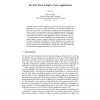Free Online Productivity Tools
i2Speak
i2Symbol
i2OCR
iTex2Img
iWeb2Print
iWeb2Shot
i2Type
iPdf2Split
iPdf2Merge
i2Bopomofo
i2Arabic
i2Style
i2Image
i2PDF
iLatex2Rtf
Sci2ools
ISOLA
2010
Springer
2010
Springer
Towards More Adaptive Voice Applications
With the Internet designed to provide best-effort packet transmission, applications are expected to adapt dynamically to the operating conditions observed in the network. For this purpose, congestion control mechanisms have been devised for various transport and (partly) application protocols, and application programs may present, e.g., data rate information to the user. While these mechanisms work well for elastic applications (such as file transfer), the perceived performance of real-time applications may degrade quickly if a minimum required quality of service cannot be achieved. We argue that the current interpretation of adaptation specifically of real-time applications is too narrow and present a framework for expanding the scope of end-to-end adaptation, using the case study of voice communications. Our approach is general in nature, but should especially support communication in mobile environments.
Congestion Control Mechanisms | Data Rate Information | Formal Methods | ISOLA 2010 | Real-time Applications |
| Added | 28 Jan 2011 |
| Updated | 28 Jan 2011 |
| Type | Journal |
| Year | 2010 |
| Where | ISOLA |
| Authors | Jörg Ott |
Comments (0)

